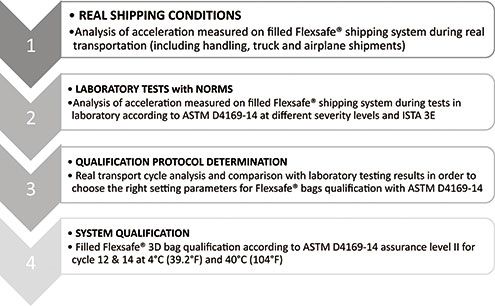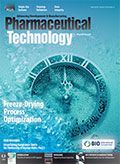Best Practices for Shipping Single-Use Systems
Shipping biopharmaceuticals in single-use containers requires a thorough understanding of the distribution cycle and potential transportation risks.
Image Courtesy of Sartorius Stedim Biotech

As single-use processing equipment becomes a more prominent part of biopharmaceutical development and manufacturing, a clear understanding of risk management and testing requirements are needed. Regulatory guidelines are not prescriptive, forcing manufacturers to develop clear strategies that will ensure that product safety and efficacy are maintained during shipment.
A thorough understanding of the distribution cycle and potential transportation risks is required. In this article, Elisabeth Vachette, senior product manager, and Jean-Marc Cappia, vice-president of marketing, both at Sartorius Stedim Biotech FMT, Aubagne, France, share with Pharmaceutical Technology some of the key issues and challenges involved, and how to meet them effectively.
Regulatory issues
PharmTech:Which regulations and standards govern long-distance shipping of liquids in single-use systems?
Vachette:Currently, there is no dedicated regulatory guidance on the subject. FDA, the European Medicines Agency (EMA), and other regulatory bodies require that companies have qualified processes and can prove that the process will meet the quality standards of the final drug product.
[Neither FDA nor EMA] provide very specific requirements. They want end users to be in control of their processes. What they say is that the process of drug making should be qualified, whether that involves filtration, bag or virus inactivation, transportation, or storage space during manufacturing.
It is up to end users to establish documented evidence providing assurance that processes are under control and meeting specs and defined quality attributes (i.e., that the process is stable, robust, and free of any leakage or contamination).The Parenteral Drug Association’s (PDA) technical report TR66 recommends that shipping systems be qualified for intended use through “proper design and testing in consultation with a packaging engineer.”
Table I: [CLICK TABLE TO ENLARGE]

Table II: [CLICK TABLE TO ENLARGE]

Conditions for international shipment must be defined. They can be based on international standards such as the American Society for Testing and Materials’ (ASTM) D4169 or the International Safe Transit Association (ISTA) 3 series (Tables I and II). The level of severity for test conditions must be based on real-world shipping conditions. We recommend a holistic, four-step approach (Figure 1).
Figure 1. Four-step testing approach. [Figure courtesy of Sartorius Stedim Biotech.]

Technical challenges
PharmTech: What major technical challenges do pharma and biopharma companies face when shipping liquids in single-use systems over long distances by air or sea?
Cappia: The first and main challenge is preserving product integrity within the bag, and the robustness and integrity of the system. Any leaks or bacterial ingress must be prevented.
During shipping, bags can move, resulting in water hammer and stress. The challenge for the supplier is, first, to design systems that can pass these tests. Currently, single-use systems use better films and technologies than they did in the past, so the bags can more readily pass ASTM test requirements, which are very aggressive.
Once the integrity and robustness challenge is overcome, end users must monitor the shocks and temperature variations that the pharmaceutical product can experience when it is shipped to its destination.
Vachette: For liquid shipping, there is a need first to understand the distribution cycle, what is really happening, and what kind of shipping transportation means you are using. By knowing the distribution cycle, process validation will integrate severe conditions over the normal distribution cycle in order to provide correct and meaningful qualification. This approach allows end users to validate processes in worst-case conditions.
ASTM’s testing involves worst-case conditions, and also requires monitoring that enables the complete traceability of product, which might include tracking temperature.
The responsibility is to define the distribution cycle. End users select a supplier of transport services and a means of transporting the product (i.e., dedicated shipment, during which product is passed in a controlled way).
For exceptions, they will use a dedicated truck with cold-chain management. The approach that is used depends on the transportation supplier, although our company offers contract supply chain management and testing services for this type of process validation.
Outsourcing testing
PharmTech: Which aspects of testing and data collection can be outsourced for single-use shipping?
Cappia: We have qualified on ASTM standards and can supply technical data to provide a view of the regime and the constraints and stresses we have applied during testing, in terms of vibrations, shocks, and shakes.
In addition, when manufacturers are simulating shipping conditions, they can send us the bags to check for integrity. We can either make a pressure or ink tests on the bag, or perform bacterial ingress tests on the bags. We offer these services to support customer validation, since they must simulate shipping conditions and ensure that results are within the proper framework.
The industry’s understanding of shipping requirements varies
PharmTech: Are most biopharmaceutical companies already aware of what they need to do to validate single-use shipping for liquid products, or are they leaving any vital steps out of the plannint process?
Vachette: The level of understanding varies. Some companies, for example, the large biotech companies, are very well prepared and understand exactly what they need to include in their validation efforts. But that is not the case for all of the smaller and mid-sized manufacturers. As a vendor, we believe that we can play a role in educating manufacturers on what is required, and providing the testing services themselves if and when needed.
Article Details
Pharmaceutical Technology
Vol. 42, No. 5
May 2018
Pages: 55–57, 61
Citation
When referring to this article, please cite it as A. Shanley, "Best Practices for Shipping Single-Use Systems," Pharmaceutical Technology 42 (5) 2018.

Pharmaceutical Tariffs Are Imminent: How Industry is Bracing for Impact
April 16th 2025On April 14, 2025, the Trump Administration launched a national security-driven investigation into pharmaceuticals, a move that will likely result in tariffs being placed on pharmaceutical drugs, ingredients, and other components that are imported from outside of the United States.
Drug Solutions Podcast: A Closer Look at mRNA in Oncology and Vaccines
April 30th 2024In this episode fo the Drug Solutions Podcast, etherna’s vice-president of Technology and Innovation, Stefaan De Koker, discusses the merits and challenges of using mRNA as the foundation for therapeutics in oncology as well as for vaccines.